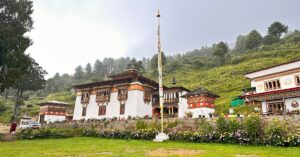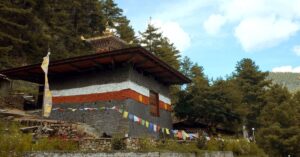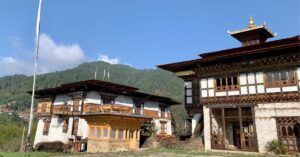Hungrel Dzong was a fortress built on the sacred site of Guru Rinpoche in the Paro Dzongkhag at 2364 meters. The Dzong was constructed by Drung Drung Gyelchog (Lama Drung Drung Gyal or Pha Drung Drung Rinpoche) in the 15th century. It was a five-story structure, built of compact mud, and resembled Namgyal Khangzang. Inside, it resembled the “Palace of the Gods“.
Though we can’t see the original Hungrel Dzong, the Paro Rinpung Dzong, which means “Fortress on a Heap of Jewels,” constructed at the Hungrel Dzong site, is considered sacred, as is the Hungrel Dzong itself. This Rinpung Dzong was built by Zhabdrung Ngawang Namgyal in 1645 AD. It’s popularly known as Paro Rinpung Dzong or simply Paro Dzong.
Hungrel Ney is one of the three sacred sites of Guru Rinpoche, where he imprinted a sacred letter “Hung”.
Also Read: The Three Sacred Sites of Guru Rinpoche, which form the Buddhist Mantra, “Om Ah Hung”
How to Reach Hungrel Gyem Lhakhang
Paro Dzong is 54 km away from the capital of Bhutan, Thimphu. Hungrel Gyem Lhakhang is located on the other side of the Pa Chhu River from the main road of Paro Town. It takes only 15 minutes on foot from Paro Town. To enter the Hungrel Dzong or Paro Rinpung Dzong, one must cross the traditional wooden cantilever bridge over the Paro River. After crossing the bridge, descend from the Dzong following the stone-steps route to reach Hungrel Gyem Lhakhang.
Sacred Relics to See at Hungrel Ney
- Paro Rinpung Dzong;
- Rinpung Drak of Guru Rinpoche;
- Hungrel Drak;
- Goenkhang of Bjawog Nyap or Jowo Nep (Hungrel Goenpo);
- Guru Sungjoenma statue;
- Two holy waters (Drupchhu), namely Jowo Drubchhu and Hungrel Drubchhu;
- The sacred word “Hung”.
Also Read: Guru Rinpoche in Bhutan: His Visits to Bhutan and Sacred Sites
Historical Significance of Hungrel Dzong
According to legend, the Hungrel was visited by Guru Rimpoche in the 8th century. He named it “Rinpung Drak”, the cliff of the heap of jewels, from which the dzong got its current name. History comes into sharper focus in the 15th century with the arrival of Gyelchog, the eldest son of Damtrul Loden Gyalpo, Phajo Drugom Zhigpo’s fourth straight ancestor.
He settled in Paro Tshongdu crematorium after his brother denied him a return to his seat. While meditating, a deity living across a river beneath a cliff tried to distract him. However, Drung Drung subdued the deity and named him Hungrel Goenpo, the protector of Buddhism.
The deity Hungrel Goenpo offered his cliff and requested Drung Drung Gyelchog to establish his seat by building a small hut atop the cliff.
Drung Drung Gyelchog established his seat and settled there. However, the regular conflicts among various lineage holders of religious traditions within the Paro valleys have saddened him. So, he made up his mind to go back to Tibet. When his patrons learned of his plan, they begged him, stating that if a lama of his stature and accomplishment resided in Hungrel Drag, all the people of Paro Valley would become his major patrons. They urged him to stay in the area and to establish a permanent settlement at Hungrel Drak.
Also Read: Historical Significance of Aja Nye
Hungrel Dzong
After considering the appropriateness of the place, Hungrel Drung Drung decided to establish a permanent seat at Hungrelkha and serve as the lama of the people of Paro. The lama quickly convened all his sponsors on an auspicious day, and the foundation for a five-story Hungrel Dzong was set. Hungrel Drung Drung is said to have carried out the work of 30 persons. He brought the required wooden structures sliding down naturally without requiring the people to get them.
Thus, a five-storied Dzong of compact mud was completed quickly. The Dzong was said to have a granary on the ground floor, an assembly hall on the first floor, residential apartments on the second floor, Gyenkhang on the third floor, and the shrine room on the fourth floor. The Dzong was named Hungrel Dzong, and the place Hungrelkha.
Hungrel Dzong, as it was known, referred to the cliff’s alternative name, Hungrel Drak, bestowed by Thangtong Gyalpo. He is credited with temporarily driving the deity out of the cliff by uttering “Hung.”
Also Read: Singye Dzong, the Mystical Lion Fortress of Guru Rinpoche
Rinpung Dzong, the Fortress on a Heap of Jewels
Zhabdrung Ngawang Namgyal visited Paro to build a Dzong in the 17th century. The descendants of Hungrel Drung Drung residing at Druk Choeding made a courtesy call on Zhabdrung Rinpoche. During the meeting, they offered the Hungrel Dzong to Zhabdrung Rinpoche, asking him not to look for any other site to build the Dzong.
Zhabdrung Rinpoche then dismantled the Hungrel Dzong and rebuilt it with the help of the first Paro Penlop, La Nangpa Tenzin Drukdra, in 1645 A.D. However, since Guru Padmasambhava had named the cliff Rinpung Drag in the 8th century, Zhabdrung renamed the dzong Rinchen Pung Dzong, which means “Fortress on a Heap of Jewels”.
Read More: Paro Rinpung Dzong, the Fortress on a Heap of Jewels
Description of Hungrel Ney
The Hungrel Ney is located just below the present-day Paro Rinpung Dzong, known as the Paro Dzong. This sacred site has a temple called Hungrel Gyem Lhakhang. It is built against the Hungrel drag (cliff) and hosts Guru Sungjoenma as the main relic. The Lhakhang has a Goenkhang of Bjawog Nyap or Jowo Nep (Hungrel Goenpo). And just below the Goenkhang are two holy waters (Drupchhu), namely Jowo Drupchhu and Hungrel Drupchhu. These Drubchhus are believed to cleanse all our impurities (drip).
Also Read: Drupchhu or Holy Spring Waters in Bhutan: Beliefs and Benefits
The Hungrel Ney still has the sacred word “Hung”. Thus, people consider Omba Ney in Trashi Yangtse, Aja Ney in Monggar, and Hungrel Ney in Paro as the three equally sacred sites attributed to Guru Rinpoche since their names begin with the letters, Om, Ah, and Hung, which form the Buddhist Mantra, “Om Ah Hung.” Therefore, many pilgrims visit these sites at least once chronologically.
Best Time to Visit Hungrel Dzong
There is no best time to visit Hungrel Gyem Lhakhang. You can visit at any time of the season. However, if you want to see the grand event at the Dzong, we recommend visiting the Dzong during the festive season. The festival season is from the 11th to the 15th day of the second month of the Bhutanese calendar, where the Rinpung Dzong hosts a grand annual festival known as Tshechu. You can visit major pilgrimage sites in Paro with the Bhutan Pilgrimage Package.
Sacred Places to Explore in Paro
Paro Rinpung Dzong: Also known as Paro Dzong, it is one of the 16 dzongs built by the Zhabdrung Ngawang Namgyal in Bhutan in 1646. It was built as a defensive fortress against the Tibetan invasions. It is one of the biggest dzongs in Bhutan.
National Museum of Bhutan: It is located just above Paro Rinpung Dzong. The National Museum, housed in a former watchtower, Ta Dzong, showcases a vast collection of ancient Bhutanese artifacts.
Druk Choeding Lhakhang: Also known as Tshongdoe Naktshang, it is a two-story temple built by Lama Ngawang Chhogyal in Paro in 1525.
Tiger’s Nest Monastery (Taktsang Monastery): The monastery is perched on the edge of a cliff, where Guru Rinpoche came here riding a tigress. It is one of the most sacred sites in Bhutan.
Kyichu Lhakhang: It is one of the oldest temples in Bhutan, built by Songtsen Gampo in 659 CE. It was built as part of the 108 temples constructed in a single day to pin down an ogress who was opposed to the spread of Buddhism.
Zuri Dzong: This is one of Bhutan’s oldest and most historically significant fortresses in the sacred site of Namthong Karpo. Built in 1352, it served as a defensive structure against invasions.
Enjoyed reading this blog?




